Table of Contents
Are you tired of the daily grind and looking for ways to achieve financial freedom? What if I told you there are proven strategies to break free from financial constraints and live the life you’ve always dreamed of?
In this guide, we’ll explore seven powerful strategies that can unlock financial freedom and change your life. Let’s dive in.
1. Supercharge Your Income with Blogging
Blogging is one of the most effective ways to unlock financial freedom. Whether you’re just starting or looking to scale, a well-executed blog can generate substantial income and provide a sustainable path to wealth. The key to success lies in understanding your audience, providing value, and strategically monetizing your content.
To truly supercharge your income through blogging, it’s essential to focus on selecting a profitable niche, using the right tools, and implementing smart strategies that attract high-paying clients. Let’s break down these critical elements so you can maximize your blogging potential.
Web Hosting Recommendations
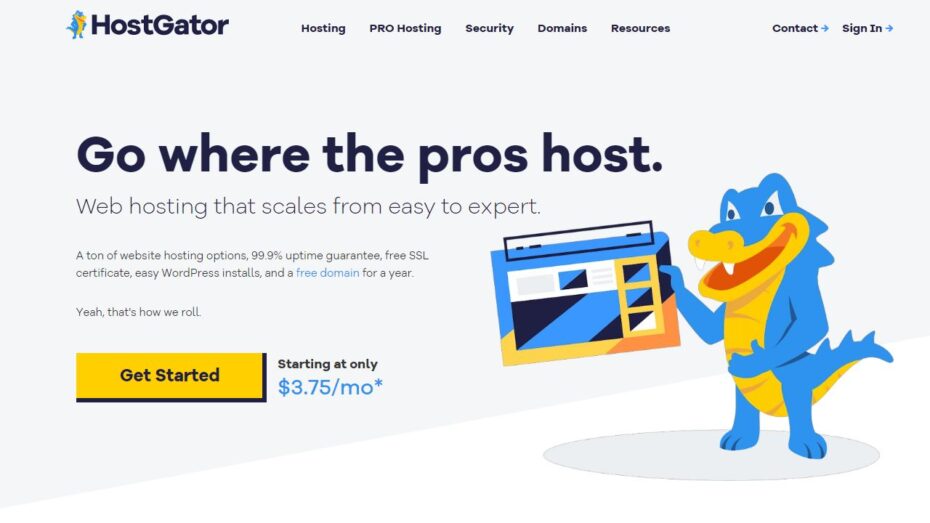 Hostgator
| 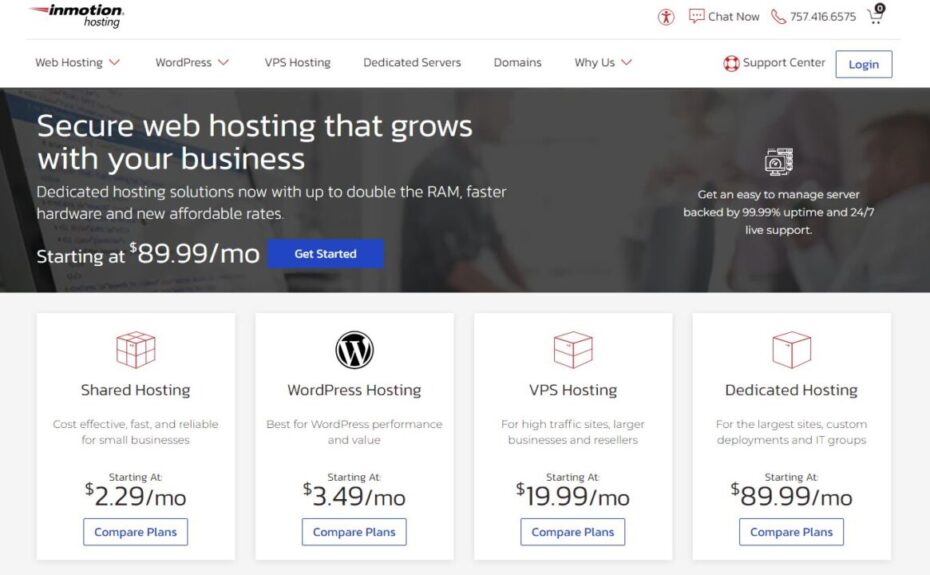 Inmotion
| 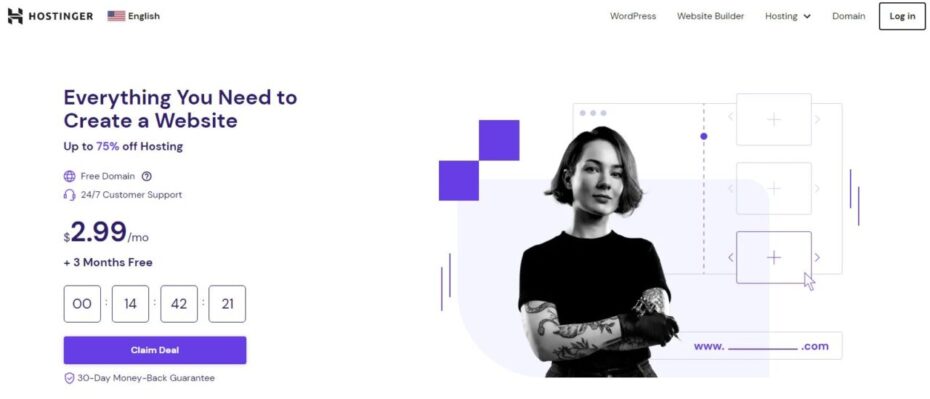 Hostinger
|
How to Choose a Profitable Niche for Blogging
Selecting a profitable niche is the foundation of a successful blog. Your niche should align with your passions and expertise while also appealing to a broad audience with a strong interest in the topic.
Start by brainstorming ideas that excite you, then research their market potential. Look for niches with substantial search volume but relatively low competition. This balance ensures that your blog can attract significant traffic without being overshadowed by established competitors.
Once you’ve identified potential niches, dive deeper into their monetization potential. Consider whether the niche has products or services that you can promote, either through affiliate marketing or creating your own offerings.
Additionally, assess the audience’s purchasing behavior. Niches with higher consumer spending typically lead to more profitable blogging ventures.
Test the waters by creating a few blog posts and monitoring their performance. If you see good engagement and traffic, it’s a sign that your niche choice is on the right track.
Remember, choosing a niche is not just about passion but also about ensuring there’s a market ready to engage with your content and, ultimately, help you achieve financial freedom.
Essential Blogging Tools to Boost Earnings
Using the right tools can significantly enhance your blogging efficiency and earnings. Start with a reliable content management system (CMS) like WordPress, which offers flexibility, SEO optimization, and a vast library of plugins to enhance functionality.
For content creation, tools like Grammarly and Hemingway help ensure your writing is clear, engaging, and free of errors, making your blog posts more compelling to readers.
SEO tools like Yoast SEO or Rank Math are crucial for optimizing your content to rank higher on search engines. These tools guide you through best practices for keyword usage, meta descriptions, and readability, ensuring your blog posts are easily discoverable by your target audience. Additionally, Kissmetrics is indispensable for tracking your blog’s performance, allowing you to make data-driven decisions that boost your income.
Email marketing platforms like ConvertKit or Aweber can help you build and maintain a relationship with your audience. By collecting email addresses and sending regular updates, you can keep readers engaged and drive repeat traffic to your blog.
Monetizing this audience through targeted offers, affiliate links, or product sales becomes much more accessible when you have a robust email list.
Lastly, consider using monetization platforms like Monetag, Adsterra, or affiliate networks to easily integrate ads and affiliate links into your content. These tools automate revenue generation, helping you earn passive income from your blog with minimal ongoing effort.
Monetizing Your Blog for Maximum Financial Freedom
Monetizing your blog effectively is key to achieving financial freedom. The first step is to diversify your income streams. Relying on just one method, like ad revenue, can be limiting. Instead, explore multiple monetization strategies to maximize your earnings.
Affiliate marketing, where you earn commissions by promoting other companies’ products, is a popular and lucrative option. Create content that naturally incorporates affiliate links, such as product reviews or how-to guides.
Selling your own digital products, such as eBooks, online courses, or exclusive content, is another powerful way to monetize your blog. These products require an upfront investment of time and effort, but they can generate significant passive income once they are live.
Additionally, offering premium memberships or a subscription model can provide recurring revenue. Loyal readers may be willing to pay for exclusive content, early access to posts, or other perks.
Sponsorships are another avenue to explore. As your blog grows, brands may approach you to promote their products or services in exchange for payment. Sponsored posts, where you write content around a brand’s offering, can be highly lucrative if your audience aligns well with the sponsor’s target market.
Finally, consider leveraging ad networks or direct ad sales. Displaying ads on your blog can generate steady income, especially as your traffic increases. While the earnings from ads might be lower compared to other methods, they still provide a reliable income stream, especially when combined with the other strategies mentioned.
Content Strategies to Attract High-Paying Clients
Creating high-quality content that resonates with your audience is essential for attracting high-paying clients. Start by understanding your readers’ pain points and desires. Develop content that addresses these issues while positioning yourself as an authority in your niche.
High-value content, such as in-depth guides, expert interviews, and data-driven articles, not only draws traffic but also demonstrates your expertise to potential clients.
Incorporating SEO best practices is crucial for making your content visible to a broader audience. Use related keywords strategically within your content to improve search engine rankings.
However, avoid keyword stuffing; your primary focus should be on providing value to your readers. High-ranking content that solves real problems can attract businesses looking to collaborate with an expert in your field.
Engage with your audience through interactive content, such as webinars, live Q&A sessions, or exclusive forums. This interaction helps build a community around your blog, increasing reader loyalty and trust. Clients are more likely to pay a premium for your services or products if they see that you have a dedicated following and can provide tangible value.
Lastly, don’t shy away from showcasing your successes and results. Case studies, testimonials, and detailed project breakdowns can be compelling proof of your capabilities. When potential clients see the direct impact of your work, they are more inclined to invest in your services, leading to higher-paying opportunities and, ultimately, financial freedom.
2. Boost Your Earnings with Affiliate Marketing
Affiliate marketing is a powerful strategy for those seeking financial freedom. With the right approach, you can generate a steady stream of income by promoting products and earning commissions on sales. The beauty of affiliate marketing lies in its flexibility and scalability, allowing you to grow your earnings over time with consistent effort and smart strategies.
To truly boost your earnings, it’s crucial to select the right affiliate programs, create compelling content, and leverage SEO to drive traffic. Let’s explore how to implement these strategies effectively to maximize your affiliate marketing success.
Selecting the Right Affiliate Programs for Financial Success
Choosing the right affiliate programs is the foundation of a successful affiliate marketing strategy. Start by identifying products or services that align with your niche and resonate with your audience. When you promote products that your readers genuinely need and trust, you build credibility and increase the likelihood of conversions.
Look for programs that offer competitive commissions and reliable tracking systems. High-commission products may seem attractive, but it’s essential to consider the quality and relevance of the product to your audience. A lower commission on a product that’s highly relevant can often result in higher overall earnings due to increased conversion rates.
Additionally, evaluate the support and resources offered by the affiliate program. Programs that provide promotional materials, regular updates, and dedicated affiliate support can significantly ease your marketing efforts. Affiliate programs with transparent policies and timely payments are also crucial for long-term success. Carefully selecting programs that align with your goals ensures that you are set up for financial success.
Creating High-Converting Affiliate Content
Once you’ve chosen the right programs, the next step is to create high-converting affiliate content. Your content should focus on solving problems for your audience while subtly introducing affiliate products as part of the solution.
For instance, writing in-depth reviews, tutorials, or comparison articles that highlight the benefits and features of the product can effectively drive conversions.
Storytelling can be a powerful tool in affiliate marketing. Share personal experiences or case studies that demonstrate the product’s effectiveness. This approach builds trust with your audience and makes your recommendations more relatable.
Additionally, creating content that answers common questions or addresses pain points related to the product increases the likelihood of conversions.
Incorporating clear and compelling calls to action (CTAs) is essential. Encourage your readers to take action, whether it’s clicking a link, signing up for a trial, or making a purchase. Position your CTAs strategically within your content to maximize their effectiveness.
Remember, the goal is to provide value while guiding your readers toward a solution that benefits both them and your affiliate earnings.
Lastly, diversify your content formats to reach a broader audience. While blog posts are effective, consider expanding into videos, podcasts, or infographics. Different formats allow you to connect with your audience in various ways, increasing the chances of conversions.
Leveraging SEO to Drive Traffic to Your Affiliate Links
Search engine optimization (SEO) is a critical component of driving traffic to your affiliate content. The more traffic you generate, the higher the potential for conversions and increased earnings. Start by conducting keyword research to identify the terms your target audience is searching for related to your niche and the products you promote.
Optimize your content with these keywords, ensuring they appear naturally throughout your articles. Focus on long-tail keywords that are specific to the product or service, as these often have lower competition and higher conversion rates.
Additionally, make sure your content is structured with clear headings, subheadings, and meta descriptions that are optimized for SEO.
Internal linking is another valuable SEO strategy. Link related articles within your blog to guide readers to more content that includes your affiliate links. This approach not only improves the user experience but also helps search engines understand the relevance and depth of your content, potentially boosting your rankings.
Building backlinks from reputable sources is also crucial for improving your SEO and driving traffic. When other websites link to your content, it signals to search engines that your site is trustworthy and valuable. Reach out to other bloggers or websites in your niche to collaborate on guest posts or link exchanges to build your backlink profile.
Maximizing Commissions with Affiliate Marketing Strategies
To truly maximize your commissions, it’s essential to implement advanced affiliate marketing strategies. One effective approach is to focus on high-ticket items or recurring commission products. High-ticket items offer larger commissions per sale, while recurring commissions, such as subscriptions, provide a steady income over time.
Utilize split testing (A/B testing) to determine which content formats, CTAs, or promotional strategies yield the best results. Testing allows you to refine your approach, ensuring that you are using the most effective methods to drive conversions. For example, you might test different CTA placements or compare the performance of text-based links versus banner ads.
Building a loyal audience through email marketing can also boost your affiliate earnings. By nurturing your subscribers with valuable content, you create trust and rapport, making them more likely to act on your recommendations. Segment your email list to deliver targeted offers that match the specific interests of your subscribers, increasing the chances of conversions.
Finally, consider collaborating with influencers or thought leaders in your niche. Partnerships can expand your reach and introduce your affiliate products to a wider audience. When an influencer endorses a product you promote, it adds credibility and can significantly impact your conversion rates. Combining these strategies with consistent effort can lead to substantial growth in your affiliate marketing income, moving you closer to achieving financial freedom.
3. Build a Profitable Email Marketing Campaign
Email marketing is a powerful tool that can help you achieve financial freedom by providing a direct line of communication with your audience. A well-crafted email marketing campaign not only nurtures relationships but also drives conversions and sales, leading to consistent and scalable income. To build a profitable email marketing campaign, it’s crucial to focus on growing a high-quality email list, crafting compelling content, and optimizing your strategies for long-term success.
Whether you’re just starting or looking to enhance your existing efforts, these strategies will guide you through the essential steps of building and maintaining an effective email marketing campaign that generates tangible results.
Email Marketing Recommendations
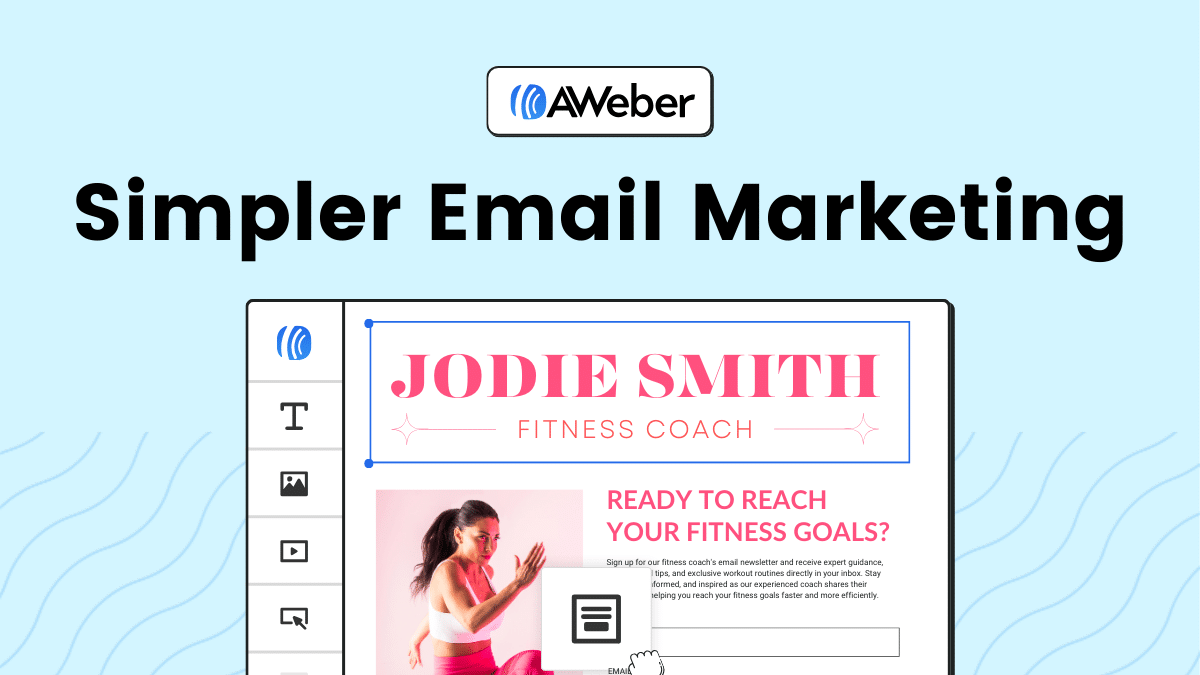 Aweber
| 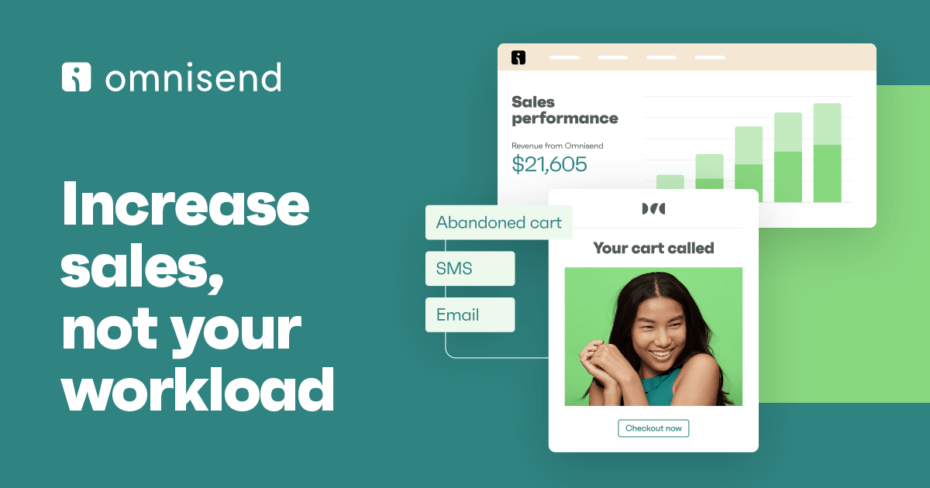 Omnisend
| 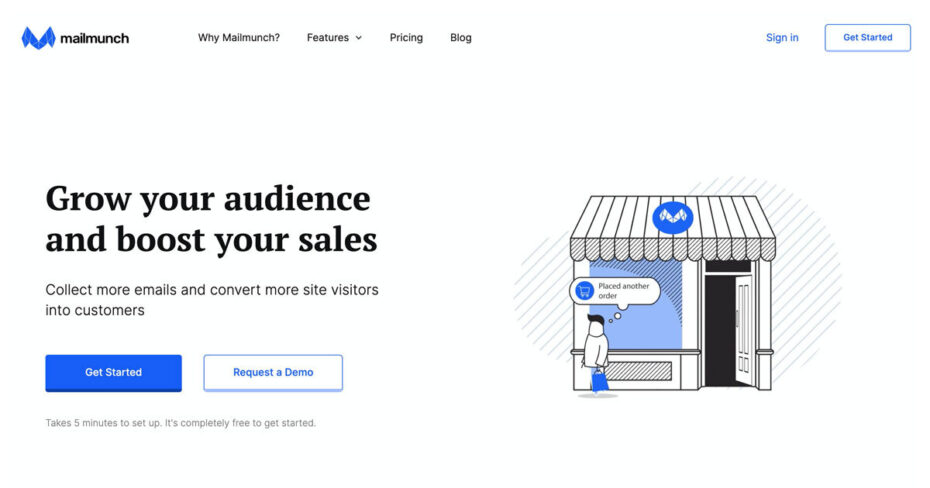 Mailmunch
|
Growing Your Email List with High-Quality Leads
Building a high-quality email list is the first step toward a successful email marketing campaign. Start by offering valuable incentives, such as free eBooks, exclusive content, or discount codes, to encourage visitors to subscribe to your list. The key is to ensure that the incentive aligns with your target audience’s interests and needs, attracting subscribers who are genuinely interested in your content or products.
Once you’ve created a compelling offer, strategically place opt-in forms on your website, blog, and social media profiles. Use engaging calls to action (CTAs) that clearly communicate the value of subscribing. For instance, instead of using generic phrases like “Sign Up Now,” try something more enticing like “Unlock Exclusive Tips for Financial Freedom.” A well-crafted CTA can significantly increase your conversion rates and help you grow your list with high-quality leads.
Segmentation is another crucial aspect of growing your email list effectively. By categorizing subscribers based on their interests, behavior, or demographics, you can tailor your email content to better meet their needs. This personalized approach not only increases engagement but also enhances the likelihood of conversions, as subscribers receive content that resonates with their specific interests.
Lastly, regularly clean your email list by removing inactive subscribers. Keeping your list up-to-date with engaged readers ensures that your email campaigns are more effective and helps maintain a high sender reputation, which is critical for email deliverability and overall campaign success.
Crafting Compelling Email Content for Increased Conversions
The content of your emails plays a significant role in driving conversions and ultimately achieving financial freedom through email marketing. Start by crafting attention-grabbing subject lines that entice recipients to open your emails. A well-written subject line should be concise, relevant, and hint at the value inside the email. Experiment with different approaches, such as asking a question, offering a solution, or creating a sense of urgency, to see what resonates best with your audience.
Once you’ve captured their attention, the body of your email should deliver on the promise of the subject line. Focus on providing value, whether it’s through educational content, special offers, or actionable tips. Keep your writing clear and concise, and avoid overwhelming your readers with too much information. Instead, break up the content with subheadings, bullet points, and images to make it easily digestible.
Personalization is key to crafting compelling email content. Address your subscribers by name and tailor the content to their preferences and behavior. For example, if a subscriber has recently shown interest in a specific product or topic, send them related content or offers. This personalized approach not only increases engagement but also fosters a stronger connection with your audience, making them more likely to take the desired action.
Finally, always include a clear and persuasive call to action (CTA) in your emails. Whether you want your readers to make a purchase, sign up for a webinar, or download a resource, make it easy for them to do so. A well-placed CTA that stands out visually and is aligned with the email’s content can significantly boost your conversion rates.
Automating Your Email Campaigns for Passive Income
Automation is a game-changer in email marketing, allowing you to create a stream of passive income while you focus on other aspects of your business. With automation, you can set up a series of emails that are sent to subscribers based on specific triggers, such as signing up for your list, making a purchase, or abandoning a cart. These automated sequences ensure that your audience receives timely and relevant content without you having to manually send each email.
One of the most effective automated campaigns is a welcome series, which introduces new subscribers to your brand, sets expectations, and provides value right from the start. A well-designed welcome series can build trust, encourage engagement, and lead to higher conversion rates. For example, your welcome series might include a thank-you message, an introduction to your products or services, and a special offer to incentivize the first purchase.
Cart abandonment emails are another powerful automation tool that can recover lost sales. If a subscriber adds items to their cart but doesn’t complete the purchase, an automated email reminding them of the items and offering a discount or free shipping can nudge them to complete the transaction. This type of automation can significantly boost your revenue with minimal ongoing effort.
Lastly, consider setting up re-engagement campaigns for subscribers who have become inactive. These automated emails can rekindle interest by offering exclusive content, limited-time deals, or simply asking for feedback. By re-engaging inactive subscribers, you can increase the overall effectiveness of your email marketing efforts and maintain a healthy and active list that contributes to your financial goals.
Analyzing Email Metrics to Optimize Campaign Performance
Analyzing the performance of your email campaigns is essential for continuous improvement and maximizing your return on investment. Start by tracking key metrics such as open rates, click-through rates, conversion rates, and unsubscribe rates. These metrics provide valuable insights into how your audience is interacting with your emails and where there might be room for improvement.
Open rates, for example, can indicate how effective your subject lines are at capturing attention. If your open rates are lower than expected, consider testing different subject lines or send times to see what resonates best with your audience. Similarly, click-through rates can help you gauge the effectiveness of your email content and CTAs. If subscribers are opening your emails but not clicking through to your website or offers, it may be time to refine your content or CTA placement.
A/B testing is a powerful tool for optimizing your email campaigns. Test different elements of your emails, such as subject lines, CTAs, images, and content length, to see what drives the best results. A/B testing allows you to make data-driven decisions that can lead to significant improvements in campaign performance over time.
Lastly, don’t overlook the importance of analyzing your unsubscribe rates. While some churn is normal, a high unsubscribe rate could signal that your content isn’t meeting subscribers’ expectations or that you’re sending too many emails. Use feedback from unsubscribers and adjust your strategy to better align with your audience’s preferences. By regularly analyzing and optimizing your email campaigns, you can ensure that your efforts continue to drive meaningful results and contribute to your journey toward financial freedom.
4. Launch a Successful Dropshipping Business
Launching a dropshipping business can be a transformative step toward achieving financial freedom. With minimal upfront investment and the flexibility to work from anywhere, dropshipping offers a low-risk way to start an online business. Success in dropshipping hinges on selecting the right products, setting up an effective store, and implementing smart marketing strategies that drive sales.
If you’re ready to dive into the world of dropshipping, this guide will walk you through the essential steps to ensure your business not only gets off the ground but thrives in the competitive eCommerce landscape.
Dropshipping Sites Recommendations
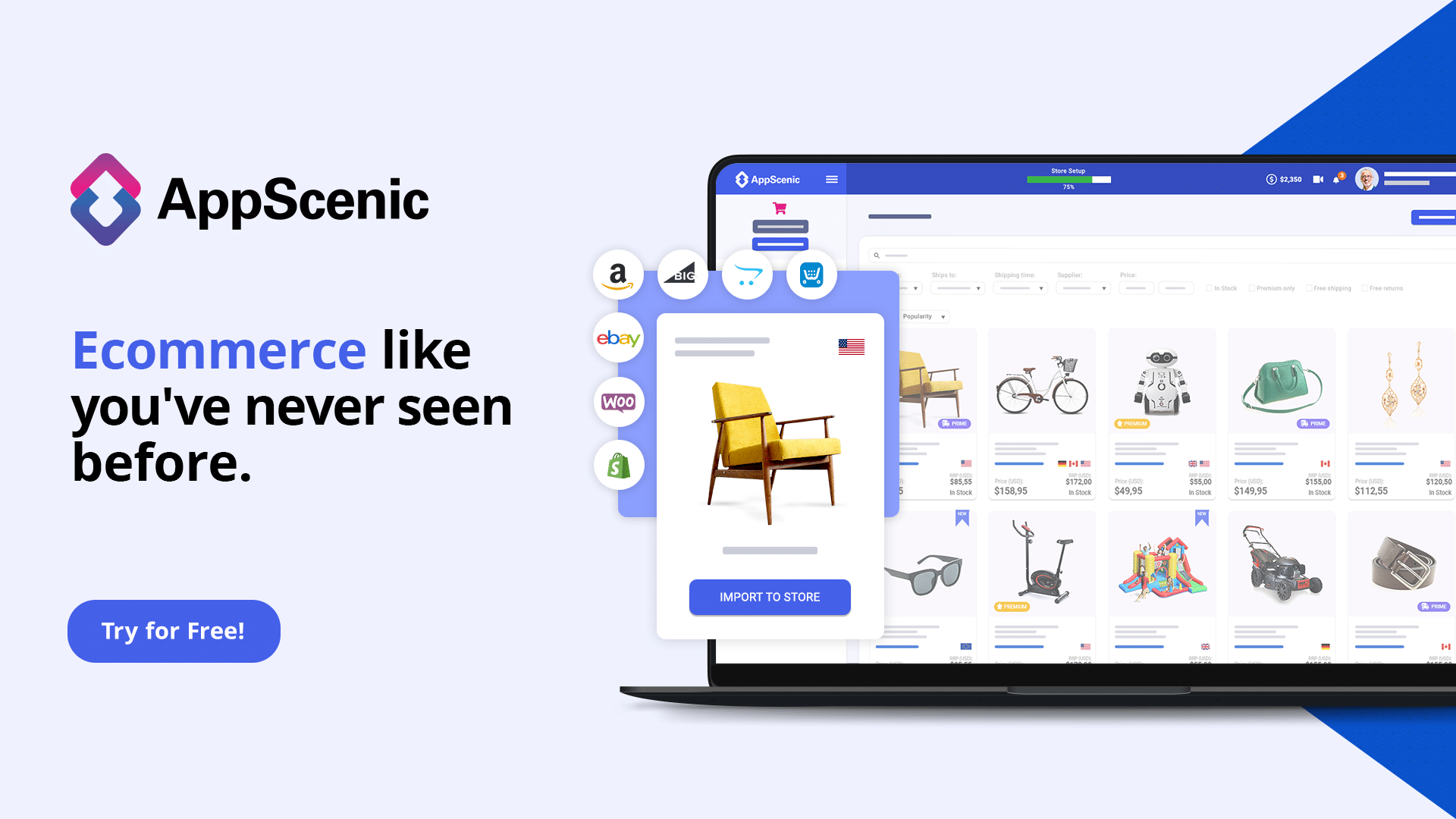 Appscenic
| 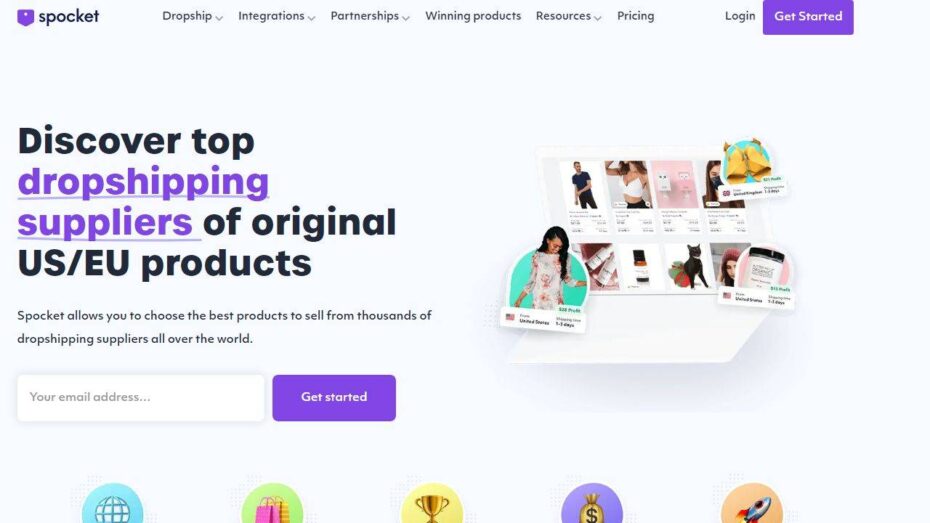 Spocket
|
Finding Profitable Products to Dropship
The foundation of a successful dropshipping business lies in choosing the right products. To find profitable items, begin by researching market trends and identifying products that are in demand but not oversaturated. Tools like Google Trends, Amazon Best Sellers, and AliExpress Hot Products can give you insights into what consumers are currently buying and searching for.
It’s crucial to select products that have a healthy profit margin. Since you won’t be buying inventory upfront, you can test various products without financial risk. Look for items that are inexpensive to source but can be sold at a higher price, ensuring you can cover your costs while still making a profit. Pay attention to shipping costs and times, as these can significantly impact customer satisfaction and your bottom line.
Narrow down your product selection by considering your target audience. Think about who would be most interested in these products and how you can reach them effectively. Products that solve a problem or cater to a specific niche often perform well, as they appeal to a dedicated group of consumers. Once you’ve identified potential products, test them on a small scale to gauge demand before fully committing.
Lastly, consider the reliability of your suppliers. Partnering with trustworthy suppliers who can consistently deliver high-quality products on time is essential for maintaining customer satisfaction and avoiding disputes. Platforms like AliExpress, Oberlo, and SaleHoo offer access to a wide range of suppliers and products, making it easier to find and vet potential partners.
Setting Up Your Dropshipping Store for Success
After selecting profitable products, the next step is to set up a professional and user-friendly dropshipping store. Your online store is your business’s face, so it’s crucial to make a great first impression. Start by choosing a platform that suits your needs, such as Shopify, WooCommerce, or BigCommerce. These platforms offer robust features, including customizable templates, secure payment processing, and easy integration with dropshipping apps.
Design your store with the customer in mind. Ensure that your site is easy to navigate, with clear categories, a search function, and high-quality images that showcase your products. Your product descriptions should be informative and persuasive, highlighting the benefits and unique features of each item. Include customer reviews and testimonials to build trust and credibility with potential buyers.
Optimizing your store for mobile devices is also essential, as a significant portion of online shopping is done on smartphones and tablets. Ensure that your site loads quickly and functions smoothly across all devices. A seamless mobile experience can significantly impact your conversion rates and overall sales.
Lastly, set up essential business systems, such as automated order processing and customer support. Use tools like Oberlo or Spocket to automate product imports and order fulfillment, saving you time and reducing the risk of errors. Provide clear contact information and a FAQ section to address common customer questions and concerns. A well-organized and efficient store setup sets the stage for long-term success in dropshipping.
Marketing Strategies to Drive Traffic and Sales
Marketing is the lifeblood of your dropshipping business, as driving traffic to your store is crucial for generating sales. Start with social media marketing, leveraging platforms like Instagram, Facebook, and Pinterest to showcase your products and engage with potential customers. Use targeted ads to reach specific demographics that are likely to be interested in your products. Visual content, such as high-quality images and videos, can be particularly effective in capturing attention and driving clicks.
Search engine optimization (SEO) is another powerful strategy for increasing visibility and attracting organic traffic to your store. Focus on optimizing your product pages with relevant keywords, clear meta descriptions, and high-quality images. Creating a blog that provides valuable content related to your niche can also boost your SEO efforts and establish your store as an authority in your industry.
Email marketing is an excellent way to nurture relationships with your customers and encourage repeat purchases. Build an email list by offering incentives, such as discounts or free resources, in exchange for sign-ups. Once you have a list, send regular newsletters featuring new products, special offers, and tips related to your niche. Personalized emails can increase engagement and drive more sales.
Influencer marketing can also be a highly effective way to reach a larger audience. Partnering with influencers in your niche allows you to tap into their established follower base. Whether through sponsored posts, product reviews, or giveaways, influencer collaborations can significantly boost your brand’s visibility and credibility, leading to increased traffic and sales.
Scaling Your Dropshipping Business for Long-Term Growth
Once your dropshipping business is up and running, the next step is to scale it for long-term growth. Start by analyzing your sales data to identify your best-selling products and most profitable marketing channels. Focus on expanding these areas by increasing your ad spend or introducing complementary products that appeal to your existing customer base.
Diversifying your product range is another strategy for scaling. Introduce new products that align with your niche and cater to your audience’s needs. Continuously test and add products to keep your store fresh and exciting. This approach not only attracts new customers but also encourages repeat business from existing customers.
Expanding into new markets can also drive growth. If you’re currently selling only to domestic customers, consider targeting international markets. This expansion can open up a whole new customer base and significantly increase your sales. Be sure to research and comply with any legal or logistical requirements when selling internationally.
Finally, investing in automation tools can streamline your operations and free up time to focus on growth strategies. Use tools that automate tasks like inventory management, order processing, and customer communication. As your business grows, consider outsourcing tasks like customer service or marketing to professionals, allowing you to focus on strategic decisions that will drive your business forward.
Scaling your dropshipping business requires careful planning and execution, but with the right strategies, you can achieve sustained growth and move closer to your goal of financial freedom.
5. Monetize Your Knowledge with Online Courses
Monetizing your knowledge through online courses is a powerful way to achieve financial freedom while sharing your expertise with a global audience. The online learning industry is booming, and with the right approach, you can create a profitable course that generates passive income over time. The key lies in choosing the right topic, creating high-quality content, and effectively marketing your course to reach the right people.
If you’re ready to turn your knowledge into a revenue stream, this guide will walk you through the essential steps to build and scale a successful online course business.
Choosing a Lucrative Topic for Your Online Course
Selecting the right topic for your online course is the first and most crucial step in ensuring its success. To choose a lucrative topic, start by assessing your expertise and identifying the areas where you can provide significant value. Think about the skills or knowledge you have that others would be willing to pay to learn. It’s essential to choose a topic that not only interests you but also has a strong demand in the market.
Conduct market research to validate your course idea. Look at popular online course platforms like Udemy, Coursera, or Teachable to see what topics are trending. Check out competitor courses in your niche and read reviews to understand what students are looking for and where there might be gaps in the market. Tools like Google Trends and keyword research can also help you gauge interest levels and identify topics with high search volume.
Once you have a few potential topics in mind, narrow them down based on profitability and your ability to deliver high-quality content. Consider the earning potential of the topic—are there opportunities for upselling, certifications, or advanced courses? A topic with a strong monetization potential will set you on the path to financial freedom more quickly.
Lastly, test your idea with your audience before fully committing to it. You could create a blog post, webinar, or mini-course on the topic to gauge interest and gather feedback. This approach allows you to refine your course idea based on real audience needs, increasing the likelihood of success when you launch your full course.
Creating Engaging Course Content that Sells
Creating engaging content is key to ensuring that your online course not only attracts students but also keeps them engaged until the end. Start by outlining your course structure, breaking down your content into manageable modules and lessons. Each module should build upon the previous one, guiding students through a clear learning path that leads to the desired outcome.
Use a mix of content formats to cater to different learning styles. While video lectures are the cornerstone of most online courses, consider incorporating quizzes, downloadable resources, interactive exercises, and discussion forums to enhance the learning experience. Engaging content not only helps students retain information better but also makes your course more valuable, justifying a higher price point.
Your course content should be clear, concise, and actionable. Avoid overwhelming your students with too much information at once. Instead, focus on delivering key concepts in a straightforward manner, followed by practical examples or exercises that reinforce the material. Providing real-world applications of the knowledge you’re teaching helps students see the value in what they’re learning and motivates them to complete the course.
Lastly, ensure that your course is visually appealing and easy to navigate. High-quality production values, such as clear audio, crisp video, and professional slides, can significantly enhance the perceived value of your course. Additionally, organize your content so that students can easily track their progress and revisit specific lessons if needed. An engaging, well-structured course not only leads to higher completion rates but also results in positive reviews and referrals, which are essential for growing your course business.
Marketing Your Online Course to a Global Audience
Once you’ve created a high-quality course, the next step is to market it effectively to reach a global audience. Start by identifying your target audience—who will benefit most from your course, and where are they likely to be found online? Understanding your audience’s demographics, interests, and pain points will help you tailor your marketing messages and choose the right platforms to promote your course.
Social media marketing is one of the most effective ways to reach potential students. Leverage platforms like Facebook, Instagram, LinkedIn, and YouTube to build an online presence and engage with your audience. Share valuable content related to your course topic, such as tips, tutorials, or behind-the-scenes insights, to attract followers and build credibility. Paid advertising on these platforms can also help you target specific demographics and drive traffic to your course landing page.
Email marketing is another powerful tool for promoting your online course. Build an email list of interested prospects by offering free resources, such as eBooks or webinars, related to your course topic. Once you have a list, nurture your leads with regular emails that provide value and subtly promote your course. Offering early-bird discounts or limited-time bonuses can create urgency and encourage sign-ups.
Collaborating with influencers or affiliates in your niche can significantly expand your reach. Partner with bloggers, podcasters, or YouTubers who have an audience aligned with your course topic. They can promote your course to their followers in exchange for a commission or other incentives. Influencer endorsements add credibility to your course and can lead to a surge in enrollments.
Lastly, consider offering a free mini-course or a preview of your full course to give potential students a taste of what they can expect. This strategy allows you to showcase the value of your course while building trust with your audience. Once they see the quality of your content, they’ll be more likely to invest in the full course.
Strategies for Scaling Your Online Course Business
After successfully launching your online course, the next step is to scale your business for sustained growth. Start by analyzing your course performance data to identify what’s working and where there’s room for improvement. Look at metrics such as enrollment numbers, completion rates, and student feedback to gain insights into how you can enhance your course and marketing efforts.
One of the most effective strategies for scaling is to create additional courses that build on the success of your first one. Consider developing advanced courses, certification programs, or related topics that appeal to your existing audience. Offering a range of courses increases the lifetime value of each student, as they’re more likely to purchase multiple courses from you if they’ve had a positive experience with the first one.
Expanding your course offerings to new markets can also drive growth. If your course is currently available only in English, consider translating it into other languages to reach a global audience. Additionally, explore opportunities to partner with organizations or educational institutions that can offer your course as part of their training programs.
Investing in automation can streamline your operations and free up time to focus on growth strategies. Use tools to automate tasks such as email marketing, lead nurturing, and course enrollment processes. This approach allows you to manage a larger student base without increasing your workload significantly.
Finally, build a community around your courses to foster engagement and loyalty. Create a private Facebook group, forum, or membership site where students can connect, share experiences, and support each other. A strong community not only enhances the learning experience but also encourages repeat business and referrals, fueling the long-term growth of your online course business and bringing you closer to achieving financial freedom.
6. Generate Passive Income with Digital Products
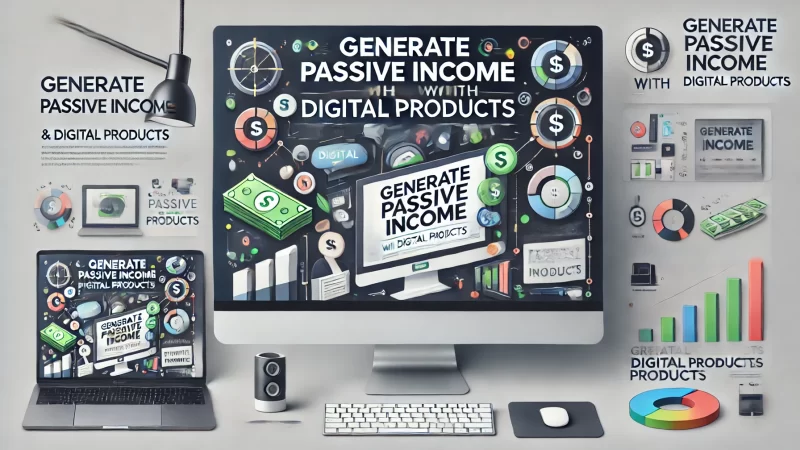
Creating and selling digital products is a powerful way to achieve financial freedom while generating passive income. Unlike physical products, digital products can be sold repeatedly without the need for inventory or shipping, making them a highly scalable business model. With the right strategies, you can develop digital products that consistently bring in revenue, allowing you to focus on other aspects of your business or personal life.
To succeed in this space, it’s essential to identify in-demand products, choose the right platforms for selling, and implement effective marketing strategies. Let’s explore how to turn your digital products into a reliable source of passive income.
Identifying In-Demand Digital Products to Sell
The first step to generating passive income with digital products is identifying what to sell. Start by exploring your skills, expertise, and passions. Consider what knowledge or tools you can offer that others would find valuable. Popular digital products include eBooks, online courses, printables, software, stock photos, and design templates. The key is to create something that not only aligns with your expertise but also meets a specific demand in the market.
Conduct market research to understand what products are currently popular and what gaps exist in the market. Look at platforms like Etsy, Gumroad, and Udemy to see what digital products are selling well. Customer reviews and feedback can provide insights into what buyers are looking for and where they feel existing products fall short. This research will help you identify opportunities to create a product that stands out and meets customer needs.
Once you have a few ideas, validate them with your target audience. You could use surveys, social media polls, or even pre-launch a product to gauge interest. This feedback is invaluable in refining your product idea and ensuring that it has a strong market fit. Products that solve a specific problem or offer a unique benefit are more likely to succeed.
Finally, consider the scalability of your product. Digital products that can be easily updated, customized, or expanded offer ongoing revenue opportunities. For instance, you could create a basic version of a product and later offer premium add-ons or updates. This approach not only maximizes your earning potential but also keeps your customers engaged over time.
Platforms for Selling Digital Products Successfully
Choosing the right platform to sell your digital products is crucial for reaching your audience and maximizing sales. There are various platforms available, each with its own strengths and audience. Start by considering platforms like Gumroad, Etsy, and Shopify, which are popular for selling a wide range of digital products. These platforms offer user-friendly interfaces, built-in payment processing, and tools to help you manage your sales.
If you’re selling online courses, platforms like Teachable, Udemy, or Thinkific are excellent options. They provide the infrastructure needed to create, host, and deliver your courses to students worldwide. These platforms often include marketing tools, such as affiliate programs and email marketing, to help you promote your courses effectively.
For more customizable options, consider setting up your own website using platforms like WordPress with WooCommerce or Squarespace. This approach gives you complete control over your branding, customer experience, and sales process. While it requires more upfront work, owning your platform allows you to build a more direct relationship with your customers and keep a larger share of your profits.
Additionally, consider leveraging marketplaces like Amazon Kindle for eBooks or Creative Market for design assets. These platforms have large built-in audiences, making it easier to get your products in front of potential buyers. However, they also come with higher competition, so it’s essential to optimize your listings with strong descriptions, keywords, and high-quality visuals to stand out.
Lastly, don’t overlook the importance of integrating your selling platform with your marketing tools. Whether you use email marketing, social media, or content marketing, ensure that your platform supports seamless integration with these channels to maximize your reach and sales.
Marketing Strategies to Increase Digital Product Sales
Effective marketing is key to driving sales of your digital products. Start by building a strong online presence where you can showcase your products and connect with potential customers. Social media platforms like Instagram, Pinterest, and Facebook are excellent for promoting digital products. Use these channels to share engaging content, behind-the-scenes looks at your creation process, and testimonials from satisfied customers. Visual content, such as high-quality images and videos, can be particularly effective in capturing attention and driving traffic to your sales pages.
Email marketing is another powerful tool for increasing digital product sales. Build an email list of interested prospects by offering free resources or discounts in exchange for sign-ups. Once you have a list, nurture these leads with regular emails that provide value and subtly promote your products. Personalized email campaigns, such as product launch announcements or special offers, can significantly boost sales.
Content marketing is also a valuable strategy for promoting digital products. Create blog posts, tutorials, or videos that provide useful information related to your product niche. This content not only helps establish you as an authority in your field but also drives organic traffic to your sales pages. Include calls to action within your content to guide readers toward your products.
Paid advertising can accelerate your marketing efforts and reach a larger audience. Platforms like Google Ads, Facebook Ads, and Instagram Ads allow you to target specific demographics and interests, ensuring that your ads are seen by people most likely to purchase your products. Test different ad creatives and targeting options to find what works best for your audience.
Lastly, consider collaborating with influencers or affiliates who can promote your digital products to their followers. Influencer marketing can be a powerful way to reach new audiences and build credibility quickly. Offer affiliates a commission for each sale they generate, incentivizing them to actively promote your products. With the right marketing strategies, you can significantly increase your digital product sales and move closer to achieving financial freedom.
Scaling Your Digital Product Business for Ongoing Revenue
Once you’ve established a successful digital product, the next step is to scale your business for ongoing revenue. Start by expanding your product line with complementary offerings that appeal to your existing customers. For example, if you’ve created an eBook, consider developing a related online course or a series of templates. This approach not only increases your revenue per customer but also keeps your audience engaged and coming back for more.
Automation is key to scaling your digital product business without adding to your workload. Use tools to automate tasks such as email marketing, customer follow-ups, and order processing. For instance, set up automated email sequences that nurture leads, promote products, and provide customer support. Automation allows you to manage a larger customer base and focus on creating new products or marketing strategies.
Expanding into new markets can also drive growth. Consider translating your digital products into other languages or targeting international audiences with tailored marketing campaigns. This expansion can open up new revenue streams and significantly increase your sales. Be sure to research the specific needs and preferences of these markets to ensure your products resonate with the new audience.
Finally, focus on building a community around your products. Create a space where your customers can connect, share their experiences, and support each other. This community can be hosted on social media, a dedicated forum, or a membership site. A strong community not only enhances customer loyalty but also provides valuable feedback and ideas for future products. As you scale your digital product business, these strategies will help you build a sustainable and profitable income stream, bringing you closer to financial freedom.
7. Achieve Financial Independence with Freelancing

Freelancing offers a flexible path to achieving financial independence while allowing you to work on your own terms. With the freedom to choose your projects, set your rates, and work from anywhere, freelancing can be a rewarding career choice. However, success in freelancing requires strategic planning, from selecting the right niches to effectively marketing yourself and managing your business.
If you’re ready to take control of your financial future through freelancing, this guide will provide you with the essential steps to build a thriving freelance career that leads to long-term financial independence.
Choosing High-Paying Freelance Niches
The first step to achieving financial independence through freelancing is selecting a niche that not only aligns with your skills but also offers high-paying opportunities. Start by evaluating your expertise and identifying industries or services that are in demand. High-paying niches often include specialized fields such as software development, digital marketing, copywriting, and graphic design. These areas are consistently sought after by businesses willing to pay a premium for top talent.
Research the market to identify which niches are currently trending and have strong earning potential. Look at job boards, freelance platforms, and industry reports to see which skills are most in demand. For instance, niches like blockchain development, AI writing, and UX/UI design have seen significant growth and offer lucrative opportunities for freelancers. Additionally, consider choosing a niche where you can offer unique value or a specialized skill that sets you apart from the competition.
Once you’ve identified a few potential niches, narrow your focus based on your interest and the potential for long-term growth. Freelancing in a niche that excites you will keep you motivated and engaged, making it easier to build a successful business. Remember, the key to a profitable freelance career is not just choosing any high-paying niche but finding one where you can consistently deliver high-quality work and build a reputation as an expert.
Lastly, consider the scalability of your chosen niche. Some niches offer more opportunities for expansion, such as moving from individual projects to consulting, creating digital products, or even building a team. Selecting a niche with room for growth ensures that you can continue to increase your earnings as you gain experience and establish your freelance business.
Building a Strong Portfolio to Attract Clients
A strong portfolio is essential for attracting high-paying clients and establishing yourself as a credible freelancer. Start by curating your best work that showcases your skills and expertise in your chosen niche. Your portfolio should highlight a range of projects that demonstrate your ability to solve problems, meet client objectives, and deliver quality results. Include case studies or detailed descriptions that explain your role in each project, the challenges you faced, and the outcomes you achieved.
If you’re just starting out and don’t have a lot of work to showcase, consider creating sample projects that reflect the type of work you want to attract. These can be hypothetical projects or pro bono work for non-profits or startups. The goal is to build a portfolio that aligns with the niche you’re targeting and demonstrates your potential to prospective clients. High-quality visuals, clear descriptions, and measurable results can make your portfolio stand out.
In addition to showcasing your work, include client testimonials in your portfolio. Positive feedback from satisfied clients adds credibility and can significantly influence a potential client’s decision to hire you. Reach out to past clients and ask for testimonials that highlight your professionalism, reliability, and the value you provided. Display these testimonials prominently in your portfolio to build trust and confidence with new clients.
Finally, ensure your portfolio is easily accessible and well-organized. Create a dedicated portfolio section on your website or use platforms like Behance, Dribbble, or LinkedIn to showcase your work. Make it easy for clients to navigate through your projects and find the information they need. A well-presented portfolio not only attracts clients but also sets the stage for negotiating higher rates, as it demonstrates your expertise and the quality of work they can expect.
Marketing Yourself Effectively to Gain More Clients
Marketing yourself effectively is crucial for gaining more clients and growing your freelance business. Start by creating a personal brand that reflects your unique skills, values, and the services you offer. Your brand should be consistent across all your marketing channels, including your website, social media profiles, and any promotional materials. A strong personal brand helps you stand out in a crowded market and makes it easier for potential clients to remember you.
Leverage social media platforms to promote your services and connect with potential clients. LinkedIn is particularly valuable for freelancers, as it allows you to network with industry professionals, showcase your portfolio, and share content related to your niche. Regularly posting valuable content, such as tips, insights, or case studies, can help establish you as an authority in your field. Engage with your audience by responding to comments, joining industry groups, and participating in discussions to build relationships and expand your network.
Another effective marketing strategy is content marketing. Create a blog, YouTube channel, or podcast where you share your expertise and insights on topics related to your niche. Content marketing not only helps you attract clients organically but also positions you as a thought leader in your industry. Over time, this can lead to more referrals and higher-paying opportunities as clients seek out experts who can deliver results.
Networking, both online and offline, is also essential for gaining clients. Attend industry conferences, webinars, and local meetups to connect with potential clients and other freelancers. Building relationships within your industry can lead to referrals and collaborations that benefit both parties. Additionally, don’t be afraid to reach out directly to potential clients with personalized pitches. Research their business needs and offer a tailored solution that demonstrates how you can add value.
Managing Your Freelance Business for Sustainable Growth
Managing your freelance business effectively is key to ensuring sustainable growth and achieving financial independence. Start by setting clear goals for your business, such as monthly income targets, the number of clients you want to work with, or the types of projects you want to pursue. Having specific goals helps you stay focused and motivated, guiding your decisions as you grow your business.
Time management is crucial for freelancers, as you’ll need to balance multiple projects and deadlines. Use tools like Trello, Asana, or Notion to organize your tasks, set priorities, and track your progress. Establish a routine that allows you to work efficiently without burning out. Remember to allocate time for both client work and business development activities, such as marketing and networking.
Financial management is another critical aspect of running a successful freelance business. Keep track of your income, expenses, and taxes to ensure you’re operating profitably. Consider using accounting software like QuickBooks or FreshBooks to manage your finances and generate invoices. Setting aside money for taxes and creating an emergency fund can help you navigate slower periods and unexpected expenses without financial stress.
Finally, continuously invest in your professional development to stay competitive and grow your business. Take online courses, attend workshops, or earn certifications to enhance your skills and expand your service offerings. Staying up-to-date with industry trends and technologies will enable you to offer more value to your clients, justify higher rates, and position yourself as a leader in your niche.
Frequently Asked Questions (FAQ)
What are the most effective strategies for financial freedom?
To achieve financial freedom, it’s essential to diversify your income streams and invest in sustainable methods. Some of the most effective strategies include blogging, affiliate marketing, email marketing, dropshipping, creating online courses, selling digital products, and freelancing. Each of these methods allows you to build passive income over time, helping you to gradually replace your active income and gain more control over your financial future.
How can blogging help me achieve financial freedom?
Blogging is a powerful tool for those seeking financial freedom. By choosing a profitable niche, creating high-quality content, and implementing effective monetization strategies such as affiliate marketing and ad revenue, you can generate a steady stream of income. Over time, a well-managed blog can provide significant passive income, allowing you to focus on other income-generating activities or personal pursuits.
What is the best way to start with affiliate marketing?
To start with affiliate marketing, first, choose a niche that aligns with your interests and has a substantial audience. Then, identify and join reputable affiliate programs that offer products or services relevant to your niche. Create content that naturally integrates affiliate links—such as reviews, tutorials, or guides—and optimize it for SEO to drive traffic. Over time, as your content gains traction, your affiliate marketing income can grow significantly, contributing to your financial freedom.
How can I effectively grow my email list for email marketing?
Growing your email list is crucial for successful email marketing. Start by offering valuable incentives like free eBooks, exclusive content, or discounts to encourage visitors to subscribe. Use opt-in forms on your website, blog, and social media profiles, ensuring that your call-to-action is compelling and clearly communicates the value of subscribing. Regularly segment your email list to tailor content to your subscribers’ specific interests, which increases engagement and conversion rates.
What are the benefits of dropshipping for achieving financial freedom?
Dropshipping is an attractive business model for those looking to achieve financial freedom because it requires minimal upfront investment and eliminates the need for inventory management. By partnering with reliable suppliers, you can sell products through your online store without holding stock. Focus on finding profitable products with high demand and low competition, and use effective marketing strategies to drive traffic to your store. As your business grows, dropshipping can provide a scalable and flexible income stream.
How do I choose a profitable niche for online courses?
Choosing a profitable niche for online courses involves identifying areas where you have expertise and there is a strong market demand. Conduct thorough market research to understand what potential students are looking for, and analyze the competition to identify gaps in the market. The best niches are those that solve specific problems or offer significant value to learners, ensuring that they are willing to pay for your course.
How can I create a steady passive income with digital products?
Creating digital products like eBooks, templates, or software can be a reliable way to generate passive income. Start by identifying in-demand products that align with your skills and interests. Once created, digital products can be sold repeatedly without additional production costs. Use platforms like Gumroad, Etsy, or your own website to sell your products and leverage SEO and content marketing to drive traffic to your sales pages. Over time, this can build a substantial and sustainable income stream.
What are the most important SEO strategies for affiliate marketing?
For successful affiliate marketing, SEO is crucial. Start by conducting keyword research to identify the terms your target audience is searching for. Optimize your content by naturally incorporating related keywords into your titles, meta descriptions, and body text. Use internal linking to guide readers to other relevant content on your site, and build backlinks from reputable sources to enhance your site’s authority. Focus on providing value through your content, as high-quality information is more likely to rank well and convert readers into buyers.
How can freelancing lead to financial independence?
Freelancing offers the flexibility to choose your projects, set your rates, and work on your terms, making it a viable path to financial independence. By specializing in high-paying niches like digital marketing, software development, or graphic design, you can attract lucrative clients. Over time, building a strong portfolio and a network of satisfied clients will allow you to command higher rates and enjoy greater financial stability, ultimately leading to financial independence.
How can I scale my dropshipping business for long-term growth?
To scale your dropshipping business, start by analyzing your sales data to identify best-selling products and effective marketing channels. Focus on expanding these areas, introducing new products, and targeting new markets. Automate your business processes, such as order fulfillment and customer service, to handle increased volume efficiently. Additionally, consider investing in paid advertising and collaborating with influencers to reach a larger audience. By continuously optimizing and expanding your business, you can achieve long-term growth and move closer to financial freedom.











